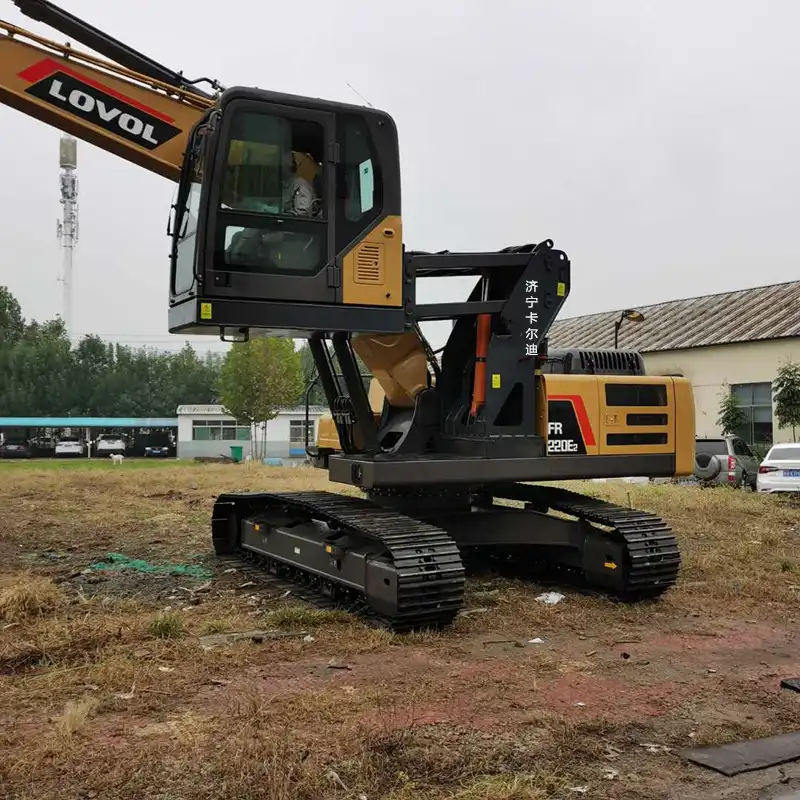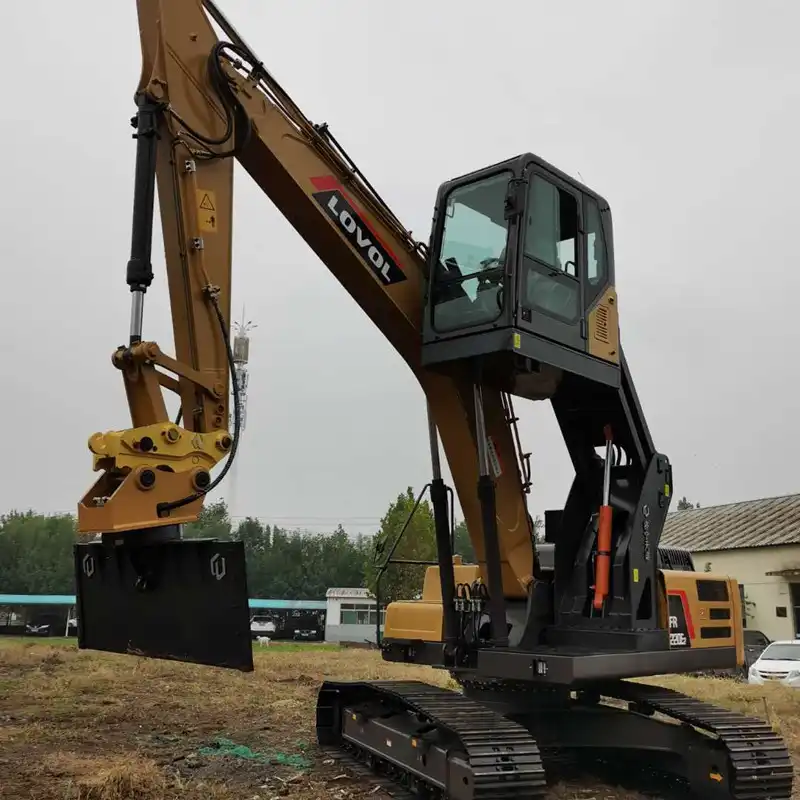How to remove the excavator cab?
Removing an excavator cab requires meticulous planning, proper safety protocols, and specialized knowledge of heavy machinery components. Whether you're upgrading to a new operator compartment, performing extensive repairs, or replacing damaged structural elements, understanding the correct dismantling sequence prevents equipment damage and ensures worker safety. The process involves systematic disconnection of hydraulic lines, electrical systems, and mechanical attachments while maintaining structural integrity throughout the operation. Professional cab removal typically takes 4-6 hours depending on machine complexity and requires specialized lifting equipment capable of handling weights between 800-1500 pounds. This comprehensive procedure demands coordination between multiple technicians and adherence to manufacturer specifications to avoid costly mistakes that could compromise both safety and equipment functionality.

Pre-Disassembly Preparations & Safety Securing
Proper preparation forms the foundation of successful cab removal operations. Before touching any components, establishing a controlled work environment becomes paramount to protecting both personnel and equipment throughout the dismantling process.
Essential Safety Equipment and Workspace Setup
Creating a secure work zone requires clearing a minimum 20-foot radius around the excavator to accommodate lifting equipment and provide safe movement corridors. Installing proper lighting ensures visibility during intricate connection work, while non-slip mats prevent accidents on potentially oil-contaminated surfaces. Personal protective equipment includes safety harnesses for elevated work, cut-resistant gloves for handling sharp edges, and safety glasses to protect against debris during disconnection procedures.
Emergency shutdown procedures must be clearly communicated to all team members, including the location of emergency stops and fire suppression equipment. Establishing clear communication protocols between ground personnel and crane operators prevents miscommunication during critical lifting phases. Weather conditions play a significant role in planning, as wind speeds exceeding 15 mph can create dangerous lifting conditions for lightweight cab structures.
Required Tools and Lifting Equipment Assessment
Professional cab removal demands specialized tooling beyond standard maintenance equipment. Hydraulic disconnect tools prevent fluid spillage during line separation, while electrical crimping tools ensure secure reconnection capabilities. Socket sets ranging from 10mm to 24mm accommodate various bolt sizes found in modern excavator cab mounting systems.
Crane capacity calculations must account for cab weight plus a 25% safety margin, typically requiring equipment rated for minimum 2,000-pound lifting capacity. Spreader bars distribute lifting forces evenly across cab attachment points, preventing structural deformation during extraction. Rigging hardware including shackles, slings, and lifting eyes must carry current inspection certifications and match load requirements specified in manufacturer documentation.
Machine Positioning and Stabilization Protocols
Positioning the excavator on level, solid ground creates a stable platform for cab removal operations. Deploying outriggers or stabilizer legs distributes machine weight and prevents settling during the dismantling process. Engine shutdown procedures include cooling system drainage to prevent thermal damage to exposed components and fuel system isolation to eliminate fire hazards.
Battery disconnection follows specific sequences to prevent electrical system damage, starting with negative terminals and progressing through auxiliary power systems. Hydraulic system depressurization releases stored energy that could cause unexpected component movement during disconnection. Documentation of original component positions through photography assists with proper reassembly and helps identify any modifications made during the equipment's service life.

System Disconnection & Mechanical Separation
Systematic disconnection of integrated systems requires understanding the interdependencies between various excavator cab-mounted components and the main machine chassis. Each system demands specific disconnection sequences to prevent damage and ensure successful reconnection during reassembly.
Hydraulic and Pneumatic Line Disconnection
Hydraulic system disconnection begins with complete pressure relief through controlled actuator movement to eliminate stored energy in accumulators and cylinders. Quick-disconnect fittings simplify the separation of auxiliary hydraulic circuits, while permanent connections require careful removal to prevent contamination of hydraulic fluid systems. Capping exposed fittings immediately after disconnection prevents debris ingress and fluid leakage that could create environmental hazards.
Pneumatic systems powering excavator cab suspension or seat adjustments follow similar disconnection protocols, though lower operating pressures reduce safety risks compared to high-pressure hydraulic circuits. Color-coded tags identifying line destinations streamline reconnection procedures and prevent costly cross-connections during reassembly. Fluid collection containers positioned beneath disconnection points capture spilled hydraulic oil and prevent workspace contamination.
Electrical System and Control Harness Removal
Electrical disconnection progresses methodically through primary power feeds, control circuits, and auxiliary systems to prevent voltage feedback that could damage sensitive electronic components. Main power harnesses typically utilize weatherproof connectors that require specific release procedures to avoid connector damage during separation. Control system wiring includes joystick connections, display units, and diagnostic interfaces that demand careful handling to preserve calibration settings.
Documenting wire harness routing through photographs ensures proper reconnection pathways and prevents interference with moving components during reassembly. Ground strap disconnection removes electrical continuity between the excavator cab and chassis, eliminating potential differences that could cause component damage. Protective covering of exposed electrical connections prevents moisture intrusion and corrosion during the cab removal period.

Structural Dismantling & Cab Extraction
Physical cab extraction represents the culmination of preparation and disconnection efforts, requiring precise coordination between lifting equipment and support personnel to safely remove the excavator cab structure without damaging surrounding components.
Mounting Point Identification and Hardware Removal
Modern excavator cabs utilize various mounting configurations including vibration-dampening mounts, rigid structural attachments, and adjustable positioning systems that require specific removal sequences. Anti-vibration mounts contain rubber elements that may deteriorate during removal, necessitating replacement during reassembly to maintain operator comfort standards. Structural mounting bolts often utilize thread-locking compounds that require heat application or specialized solvents for safe removal without thread damage.
Torque specifications for mounting hardware vary significantly between manufacturers, with some applications requiring over 300 ft-lbs of torque that demands impact tools for efficient removal. Sequential loosening patterns prevent structural stress concentration that could cause mounting bracket deformation or crack propagation. Access limitations around certain mounting points may require partial component removal or specialized angled tools to reach concealed fasteners.
Lifting Procedures and Load Distribution
Proper rigging techniques distribute lifting forces across multiple attachment points to prevent structural deformation during extraction. Manufacturer-specified lifting points ensure load paths through reinforced structural elements rather than thin sheet metal that could tear under concentrated loads. Spreader beam utilization maintains proper load geometry and prevents side loading of lifting equipment that could cause rigging failure.
Lift execution requires constant communication between crane operator and spotters monitoring clearances and potential interference points during cab movement. Initial lifting should progress slowly to verify rigging security and identify any overlooked connections that could resist cab removal. Emergency procedures include immediate load lowering protocols should unexpected resistance or rigging concerns develop during the extraction process.
Final Extraction and Component Protection
Controlled extraction velocity prevents momentum buildup that could cause cab collision with surrounding structures or equipment. Protective covering of exposed machine components shields against debris or fluid contamination during cab movement. Clear egress paths ensure safe cab placement in designated storage areas without compromising workspace organization or creating hazards for ongoing operations.
Quality inspection of removed cab structure identifies damage requiring repair before reinstallation and ensures mounting interfaces remain within specification tolerances. Documentation of extraction procedures provides valuable reference material for future maintenance operations and helps identify process improvements for enhanced efficiency. Proper storage positioning protects the excavator cab from weather exposure and accidental damage while awaiting repair or replacement activities.
FAQ
①How long does excavator cab removal typically take?
Professional cab removal usually requires 4-6 hours depending on machine size and complexity, including all preparation and safety procedures.
②What lifting capacity is needed for cab removal?
Most excavator cabs weigh 800-1500 pounds, requiring lifting equipment rated for minimum 2,000 pounds with appropriate safety margins.
③Can cab removal be performed without specialized tools?
While basic removal is possible with standard tools, specialized hydraulic and electrical disconnect equipment significantly improves safety and prevents component damage.
④What safety certifications are required for this work?
Rigging certification, crane operation licenses, and hydraulic system training are typically required for professional cab removal operations.
⑤How should removed cabs be stored?
Cabs should be stored in covered areas on level surfaces with protective covering over openings to prevent weather damage and contamination.
Explore Tiannuo's excavator cab - the perfect upgrade for your excavation fleet! Suitable for models between 13-40 tons, it boasts an above train assignment style, customizable effective pass height and width of up to 4300 mm and 4200 mm respectively, 4 sturdy legs, crawler walking operation controlled by the main machine's track lever, protective railings for safety, and a bucket capacity of 2-3.5 cubic meters. Discover the efficiency and reliability it offers. Reach out to us at arm@stnd-machinery.com to learn more.
References
- Heavy Equipment Maintenance Manual: Advanced Procedures for Excavator Component Removal, Industrial Press, 2023
- Safety Protocols in Construction Equipment Servicing: A Comprehensive Guide to Cab Removal Operations, Safety Publications Ltd., 2024
- Hydraulic System Disconnection Procedures for Mobile Equipment: Technical Standards and Best Practices, Engineering Publications, 2023
- Crane Operations Manual for Heavy Equipment Maintenance: Rigging and Lifting Procedures, Crane Safety Institute, 2024
- Excavator Service Manual: Structural Component Removal and Installation Guidelines, Heavy Machinery Technical Press, 2023
About Author: Arm
Arm is a leading expert in the field of specialized construction and railway maintenance equipment, working at Tiannuo Company.

